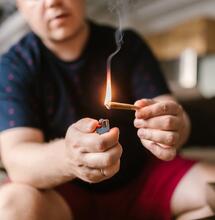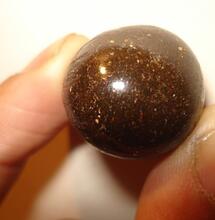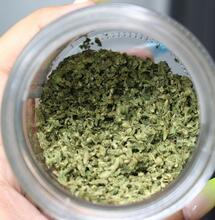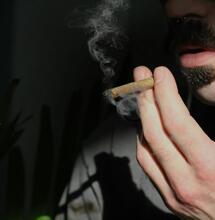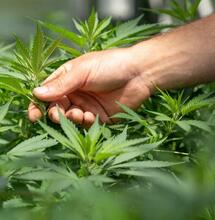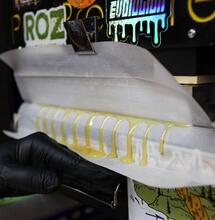Rosin Dabs!
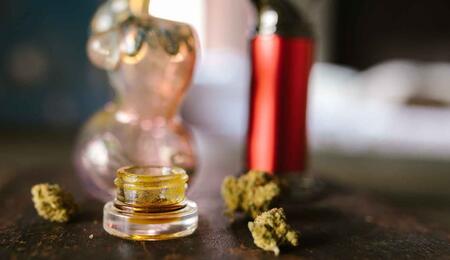
Marijuana extracts come in many forms and can be used in multiple ways. Infused edibles are prominent on the market, convenient enough even for skeptics who have never been much into smoking. Cannabutter or oil are used to prepare various meals, including sweet and savory dishes. Hash is one of the most popular extracts; this one is easy to extract and smoke. Hash aficionados use the bubble hash method (also called "ice hash") to collect hash from weed by deluging the dried flower in ice-cold water, a process that breaks off the trichomes. The result is a solid dry chunk that can then be smoked, bonged, or... dabbed! And now that I got your attention all you dab-loving folks out there, there are quite some other luscious extracts that you can dab. One of them is rosin, and perhaps you've already tried it. If you haven't, we discuss all there is to rosin dabs in this article!
What is dabbing?
For those unfamiliar with dabs or dabbing, a dab typically is a piece of concentrate placed on a hot surface so it burns into smoke instantly and the smoke is inhaled. Users who like a good dab usually use rigs that look similar to everyday glass pieces, or it can even be a stem addition to a piece you already have. Most instruments for dabbing have a large cylinder bowl shape, often with a nail or cone shape made of glass inside. The gadget allows you to heat the product with an electronic element or blowtorch and catch and direct the smoke around it as you inhale. Dabs burn the moment they are exposed to the heated surface. It only takes a small amount of concentrate to feel an intense high, which is all the catch for everyone who loves dabbing!
What is rosin?
Rosin is an extract that can come from cannabis flower, kief, or hash. Each of these three types or forms of cannabis can be molded into rosin wax. By the looks, rosin is so similar to shatter or sap that sometimes you can't tell one from another. However, one significant difference is that rosin doesn't contain any residual solvent such as from butane or propane. Rosin is a solvent-free extract, and its extraction technique is pretty easy to try and give it a go.
The appearance and texture of rosin may still vary slightly, depending on what tools were used for its manufacture as well as the starting material used. But typically, rosin will have a bit yellow or cream color. It can have the consistency of a sticky syrup or can also remind you of buttercream. Rosin concentrates boost a rich terpene profile and maintain high cannabinoid content. As a solventless extract, you get a more organic, cleaner product.
Extractors recommend exposing rosin to cold if you are not using the product immediately. Cold helps preserve the product consistency and also helps avoid getting an overly sticky substance that's difficult to handle and dab.
How is rosin made?
Unlike other concentrates, rosin is easy and safe to prepare. Solventless extraction is simple to conduct both if you want to produce small or larger quantities of concentrate.
Rosin is acquired from the resin in flowers, bubble hash, or kief, with the application of heat and pressure. Manufacturers typically use a special rosin bag or between two sheets of parchment paper, which is then battered with a heated hydraulic press to extract rosin.
As ridiculous as it may sound, if you want to prepare rosin at home, you need to make use of tools such as a hair straightener or a flat iron; alongside parchment paper and dab tools or dabbers to collect the rosin. As a precaution, to avoid getting a burn while handling the heated tool, wear heat-resistant gloves.

How to prepare homemade rosin?
Once you have your starting material (e.g., flower) and have the tools for heating/pressing and collecting, proceed to make your rosin by following the steps laid out below.
- Turn on your iron or hair straightener to a low temperature. The applied heat should be around 300°F (or about 150°C). Too much heat will destroy the terpenes, which, you do want to preserve for a satisfactory end product. Whichever appliance you utilize, be careful with the temperature settings and use protection for your hands.
- Cut a small piece of parchment paper and fold it in half. Then put the dried flower you set aside for rosin in the folded paper.
- Firmly press the folded parchment with your heating device. It will take a couple of seconds before you hear something like a crackling sound, which signals the resin has melted from the dried flower, and that's when you remove the heated pressure.
- Unfold the parchment paper and take out the flattened chunk of weed. Then use your dabber/dab tool to collect the substance oozed from the pressing. This part can be pretty sticky, so handle it with patience and caution.
- Flatten the rosin to your preference and clean it from remains of the plant material if there's any.
- Expose your finished product to a cold surface for a few seconds for a more consistent extract.
How to consume rosin?
Rosin dab vaporizing is by far the most popular way to consume rosin. But besides dabbing, rosin can also be spread on a joint, blunt, or spliff, pretty much just like any other concentrate. A lot of people keen on rosin take a "cold start" as they place the dab in the bowl before heating; this allows for a more gradual release of vapor and rosin content, resulting in a much smoother, nicer hit.
Whichever way you decide to take your rosin hits, have fun and enjoy it!
